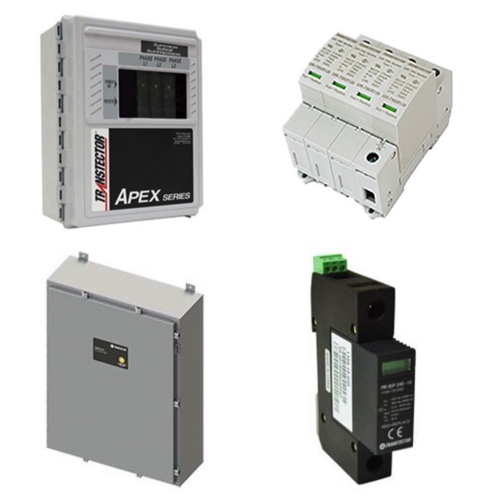Transtector AC Line Surge Protection

Transtector AC surge protectors are designed to safeguard electrical systems and connected equipment from transient voltage surges caused by lightning, switching events, and power disturbances. Available in single-phase and three-phase configurations, these surge protection devices (SPDs) support a wide range of industrial, commercial, and infrastructure applications. Multiple enclosure styles and seven different mounting options allow for flexible installation across control panels, service entrances, and distributed protection points.
The Transtector IMAX Series uses a hybrid silicon diode and thermally protected MOV design to provide bidirectional line and load protection. These units feature field-replaceable suppression modules and visual and remote status monitoring. The APEX IMAX HT Series is engineered for 120/208 VAC, 120/240 VAC, and 120 VAC systems and includes an outdoor-rated EMI-shielded enclosure, Form C remote alarm contacts, and low voltage protection levels under high induced surge conditions.
Additional Transtector product lines address specialized protection needs. The E3PA Series provides military-grade, fail-safe fusing with continuous downstream protection. The PV Series incorporates thermally protected MOV technology with audible alarms, phase-by-phase visual and remote status indication, and EMI/RFI noise filtering. SP Series surge protectors offer compact Type 1 and Type 2 protection with LED status indication. For DIN rail applications, the I2R IEP Series features replaceable SASD-based modules with bidirectional protection, while the I2R T125 and I2R 75K Series provide high-capacity MOV protection across multiple voltage and system configurations.
FAQs
Q: What is an AC surge protector?
An AC surge protector, also called an SPD or TVSS, is installed on an alternating current power line to divert excessive transient voltage to ground, protecting electrical and electronic equipment from damage.
Q: What causes power surges in electrical systems?
Power surges are commonly caused by lightning strikes, switching of motors or transformers, utility power disturbances, and operational events such as starting equipment or opening circuit breakers.
Q: What is the difference between single-phase and three-phase surge protectors?
Single-phase surge protectors are used in systems with one alternating voltage waveform, while three-phase surge protectors are designed for industrial and commercial systems that distribute power across multiple phases.
Q: What does bidirectional protection mean?
Bidirectional protection means the surge protector can suppress transient voltages coming from either the line side or load side of the electrical system.
Q: How should surge protection be applied in an electrical system?
Surge protection is most effective when applied in tiers: Tier 1 at the service entrance, Tier 2 at distribution or control panels, and Tier 3 at individual equipment or instrumentation.
Why Buy Transtector AC Surge Protectors from RSP Supply
RSP Supply offers a comprehensive selection of Transtector AC surge protectors to support a wide range of voltage levels, system configurations, and mounting requirements. From service entrance protection to DIN rail modular solutions, our Transtector inventory helps customers implement effective surge protection strategies across industrial and commercial environments. Our technical expertise and product selection support reliable system performance and long-term equipment protection.

